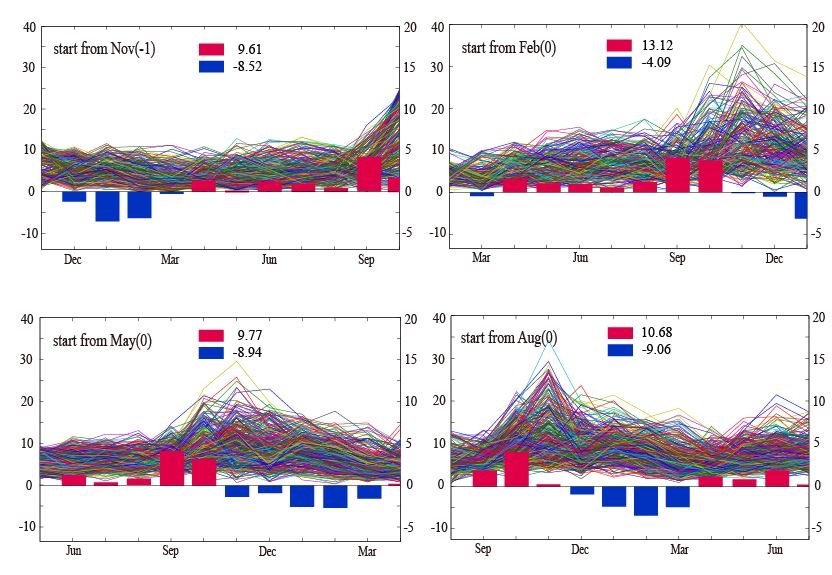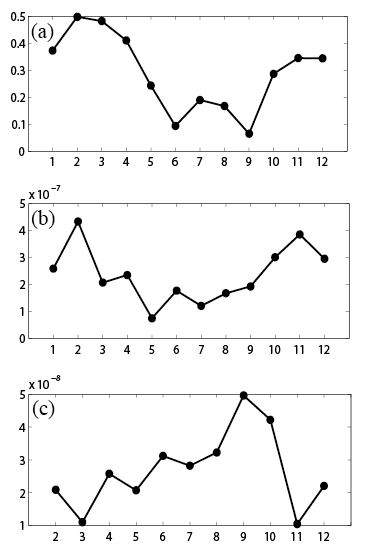State Key Laboratory of Numerical Modeling for Atmospheric Sciences and
Geophysical Fluid Dynamics (LASG)
Institute of Atmospheric Physics, Chinese Academy of Sciences

Vol. 1/No.1 December 2016
Seasonal Predictability of Sea Surface Temperature Anomalies over the Kuroshio-Oyashio Extension: Low in Summer and High in winter
In the North Pacific, the Kuroshio–Oyashio Extension (KOE) is located in the region in which the SST variability is most significant, and the seasonal evolution of SSTA in the KOE region plays a critical role in modulating the weather and climate in North America and East Asia. However, several attempts have demonstrated that the seasonal prediction skill of North Pacific SSTA, especially the SSTA in the KOE region, is quite low. Therefore, exploring the seasonal predictability is very necessary for us to better understand the variability of SSTA in the KOE region and improve the prediction skill.
Recently,Prof. DUAN Wansuo (LASG, IAP, CAS), together with his collaborators,revealed the seasonal predictability of SSTA in the KOE region by performing perfect model predictability experiments from the viewpoint of initial error growth in a global coupled model. They found that prediction errors of KOE–SSTA always increase in the boreal summer and decrease in the boreal winter (Figure 1). This leads to smaller (larger) prediction errors and higher (lower) prediction skills in boreal winter (summer), implying a season-dependent predictability that is lower in summer and higher in winter. The mechanism responsible for the error growth associated with seasonal predictability is also explored. The error increasing in summer and error decreasing in winter in the KOE–SSTA are both largely attributed to the seasonal evolution of latent heat flux error and mean temperature advection by vertical current error in the KOE region, both of which are forced by the prediction error of one-month leading zonal wind stress per unit mass for the mixed layer over the KOE region. The shallowest (deepest) mixed layer in summer (winter) amplifies (reduces) the forcing of zonal wind stress errors on the error growth of KOE–SSTA (Figure 2), thereby causing the seasonal evolution of prediction errors of KOE–SSTA and ultimately resulting in the season-dependent predictability of the KOE–SSTA, i.e., low in summer and high in winter.
The paper has been published in Journal of Geophysical Research: Oceans in 2016.

Figure 1. Monthly evolution of prediction errors of KOE–SSTA (color lines; left ordinate; each line corresponds to one initial error) and the monthly error growth tendencies (color bars; right ordinate). The results are obtained by taking the ensemble mean of all the predictions from the start months November (−1), February (0), May (0) and August (0). The red bars represent error increase and blue bars denote an error decrease. The sums of the total error increase and total error decrease are also plotted in the figure.

Figure 2.(a) The monthly signal-noise ratio of the zonal wind stress in the KOE region; (b) The monthly region-mean prediction errors of zonal wind stress averaged in the KOE region averaged by all the predictions of KOE–SSTA events. Unit: N/m2; (c) The monthly prediction errors of one-month leading zonal wind stress in KOE region divided by the climatological mean mixed-layer depth. Unit: N/m3.
Citation:
Wu, Y., W. Duan, and X. Rong (2016), Seasonal predictability of sea surface temperature anomalies over the Kuroshio-Oyashio Extension: Low in summer and high in winter, J. Geophys. Res. Oceans, 121, doi:10.1002/ 2016JC011887.
Download: http://onlinelibrary.wiley.com/doi/10.1002/2016JC011887/abstract
Contact: DUAN Wansuo, duanws@lasg.iap.ac.cn
E-mail: lasg_newsletter@lasg.iap.ac.cn
Editors: Chuanyi Wang (wangcy@lasg.iap.ac.cn), Kangjun Chen(ckj@lasg.iap.ac.cn)